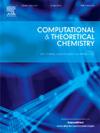Investigation of the detection of Thioguanine anti-cancer drug by using of X12O12 (X = mg, Zn) nanocage
IF 3
3区 化学
Q3 CHEMISTRY, PHYSICAL
引用次数: 0
Abstract
Nanomaterials play a vital role in pharmaceutical research, particularly in cancer treatment like Thioguanine (TG). This study aimed to investigate how sensitive MgO and ZnO nanocages are in detecting TG through application of density functional theory (DFT). Various analyses have been executed, including examinations of sensor mechanism, non-covalent interactions (NCI), natural bond orbitals (NBO), frontier molecular orbitals (FMOs), and adsorption energy (Eads). Nitrosourea adsorption on ZnO demonstrates the highest Eads values at −53.98 kcal/mol, whereas MgO complexes exhibit lower Eads. Energy gaps (Eg) of MgO and ZnO decline from 6.76 eV and 5.98 eV, respectively, compared to bare nanocage, revealing potential for utilizing these cages in Thioguanine detection. Analysis of frontier molecular orbitals indicates that 6 m-ZnO@TG complex exhibits the smallest Eg at 2.33 eV among all designed complexes. Additionally, recovery time of TG from MgO nanocages is notably shorter compared to ZnO nanocages. Topological analysis suggests a non-covalent interaction between ZnO and MgO nanocages. Furthermore, electrical conductivity values rise following the adsorption process. ZnO complex exhibits the highest electrical conductivity. Sensor mechanism demonstrates heightened sensitivity in ZnO complexes attributed to their narrow energy gaps. Consequently, ZnO stands out as a promising candidate for detecting TG and as a delivery system for TG in cancer treatment.

X12O12 (X = mg, Zn)纳米笼检测硫鸟嘌呤抗癌药物的研究
纳米材料在药物研究中发挥着至关重要的作用,特别是在治疗癌症方面,如硫鸟嘌呤(TG)。本研究旨在通过密度泛函理论(DFT)研究MgO和ZnO纳米笼检测TG的敏感性。进行了各种分析,包括传感器机制、非共价相互作用(NCI)、自然键轨道(NBO)、前沿分子轨道(FMOs)和吸附能(Eads)的检查。亚硝基脲在ZnO上的吸附Eads值最高,为- 53.98 kcal/mol,而MgO配合物的Eads值较低。与裸纳米笼相比,MgO和ZnO的能隙(Eg)分别从6.76 eV和5.98 eV下降,揭示了利用这些笼在硫鸟嘌呤检测中的潜力。前沿分子轨道分析表明,6 m-ZnO@TG配合物的Eg值最小,为2.33 eV。此外,从MgO纳米笼中回收TG的时间明显短于ZnO纳米笼。拓扑分析表明ZnO和MgO纳米笼之间存在非共价相互作用。此外,电导率值随着吸附过程而升高。ZnO配合物表现出最高的导电性。由于ZnO配合物具有较窄的能隙,传感器机制显示出较高的灵敏度。因此,ZnO是一种很有前途的检测TG的候选材料,并可作为TG在癌症治疗中的递送系统。
本文章由计算机程序翻译,如有差异,请以英文原文为准。
求助全文
约1分钟内获得全文
求助全文
来源期刊

Computational and Theoretical Chemistry
CHEMISTRY, PHYSICAL-
CiteScore
4.20
自引率
10.70%
发文量
331
审稿时长
31 days
期刊介绍:
Computational and Theoretical Chemistry publishes high quality, original reports of significance in computational and theoretical chemistry including those that deal with problems of structure, properties, energetics, weak interactions, reaction mechanisms, catalysis, and reaction rates involving atoms, molecules, clusters, surfaces, and bulk matter.
 求助内容:
求助内容: 应助结果提醒方式:
应助结果提醒方式:


